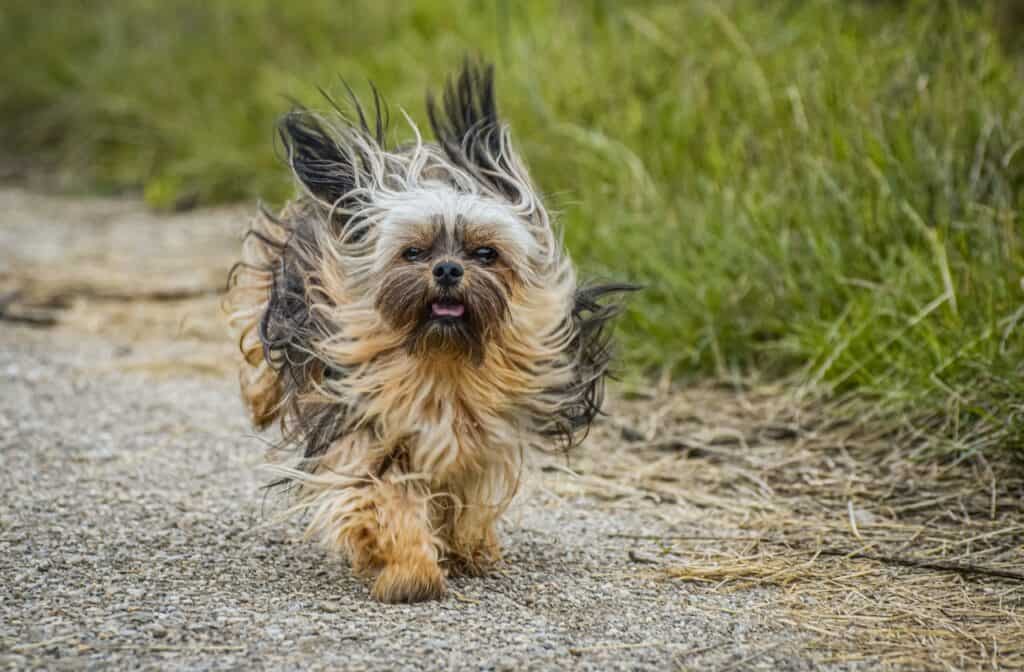1. Introduction
Brief Overview of the Lhasa Apso
The Lhasa Apso is a small, non-sporting dog breed with a rich history rooted in Tibetan monasteries. Known for their long, flowing coats and distinctive facial features, Lhasa Apsos were originally bred as sentinel dogs to alert monks to intruders. Despite their small size, they possess a bold and independent personality, making them both charming companions and vigilant watchdogs. Today, Lhasa Apsos are cherished as loyal and affectionate pets, admired for their regal appearance and spirited nature.
Key Characteristics and Traits
Lhasa Apsos are compact, sturdy dogs with a luxurious double coat that can reach the ground. They are known for their alert and confident demeanor, often displaying a regal presence. Their expressive eyes and distinct beard and whiskers give them a unique and appealing look. Lhasa Apsos are intelligent, independent, and can be somewhat aloof with strangers, but they form strong bonds with their families. They are known for their longevity and generally live well into their teens.
2. Deep Scientific Insights of the Lhasa Apso
Cognitive Abilities and Intelligence
Lhasa Apsos are highly intelligent dogs, known for their keen problem-solving skills and sharp memory. They can quickly learn commands and tricks, though their independent nature may sometimes make training a challenge. Research has shown that Lhasa Apsos possess high adaptive intelligence, meaning they excel at learning from their environment and experiences. Their ability to think independently was essential in their historical role as watchdogs, where they needed to make decisions without direct guidance.
Detection Skills and Olfactory Research
While Lhasa Apsos are not typically used in professional detection roles, they possess a well-developed sense of smell. Studies on small breed dogs, including Lhasa Apsos, indicate that their olfactory abilities are quite acute. Their natural vigilance and strong sense of smell make them excellent at detecting changes in their environment, which historically helped them alert monks to any unusual activity.
Behavioral Genetics and Temperament
The temperament of the Lhasa Apso is influenced by both genetics and upbringing. Research into canine behavioral genetics has identified specific genes associated with traits such as independence, alertness, and sociability. A study from the University of Helsinki highlighted the role of the dopamine receptor D4 gene (DRD4) in influencing exploratory and bold behaviors in small breeds like the Lhasa Apso. Understanding these genetic influences helps breeders and owners manage and cultivate the desirable traits of the breed, ensuring well-balanced and well-socialized dogs.
Role in Medical Therapy and Assistance
Lhasa Apsos, with their calm and loyal nature, can serve as effective therapy dogs. Research from the Mayo Clinic and other institutions has demonstrated the positive impact of therapy dogs on patients’ mental and emotional well-being. While not as commonly used as larger breeds, Lhasa Apsos’ affectionate disposition and ability to form strong bonds with their owners make them suitable for providing emotional support and companionship, particularly to individuals dealing with stress and anxiety.
3. History and Origin
Origin of the Lhasa Apso
The Lhasa Apso hails from the mountains of Tibet, where it was bred by Buddhist monks over a thousand years ago. These dogs were named after the sacred city of Lhasa and were considered sacred themselves. Lhasa Apsos were kept as indoor watchdogs in monasteries and palaces, alerting monks and nobles to any intruders. Their keen senses and loud, distinct bark made them excellent at their sentinel duties.
Historical Roles and Significance
Historically, Lhasa Apsos were more than just watchdogs; they were believed to bring good luck and were highly valued by Tibetan monks and nobility. The breed’s association with the Dalai Lama and their role in spiritual and cultural contexts elevated their status in Tibetan society. In the early 20th century, Lhasa Apsos were introduced to the Western world, where they quickly gained popularity as charming and loyal companions.

4. Physical Characteristics
Size and Weight of the Lhasa Apso
Lhasa Apsos are small dogs, typically standing between 10 to 11 inches tall at the shoulder and weighing between 12 to 18 pounds. Despite their small stature, they have a sturdy and well-proportioned build, giving them an air of elegance and robustness.
Coat Type and Color
The Lhasa Apso’s coat is one of its most distinctive features. They have a long, dense, double coat that provides excellent protection against the elements. The coat can come in a variety of colors, including black, white, gold, and various shades of brown and grey. Regular grooming is essential to maintain the coat’s health and appearance, as it can easily become matted if not properly cared for.
Distinctive Features
Lhasa Apsos have a distinctive face with a short, square muzzle, large, dark eyes, and heavily feathered ears. Their expressive eyes and well-defined whiskers and beard give them a unique and appealing look. The breed’s overall appearance is one of alertness and confidence, with a strong, balanced frame that belies their small size.
5. Temperament and Personality
General Behavior and Traits of the Lhasa Apso
Lhasa Apsos are known for their confident, independent, and sometimes stubborn nature. They are highly alert and make excellent watchdogs, often being wary of strangers but deeply loyal to their family. Lhasa Apsos are intelligent and curious, enjoying mental stimulation and interactive play. Despite their small size, they can be quite assertive and are not afraid to stand their ground.
Interaction with Family, Children, and Other Pets
Lhasa Apsos form strong bonds with their families and are affectionate and protective companions. They are generally good with children, though their independent nature means they may not tolerate rough play. Supervision is recommended when Lhasa Apsos interact with young children to ensure respectful handling. With proper socialization, Lhasa Apsos can get along well with other pets, though they may exhibit a dominant personality and should be introduced to new animals gradually.
6. Health and Common Diseases
Typical Lifespan of the Lhasa Apso
The typical lifespan of a Lhasa Apso is quite long, ranging from 12 to 15 years or more with proper care. Their longevity is one of the breed’s appealing characteristics, offering many years of companionship to their owners.
Common Health Issues and Genetic Conditions
Lhasa Apsos are generally healthy dogs, but like all breeds, they are prone to certain health issues. Common problems include hip dysplasia, patellar luxation, and eye conditions such as progressive retinal atrophy (PRA) and cataracts. They are also susceptible to allergies and skin problems, which can be managed with proper diet and care. Regular veterinary check-ups, a balanced diet, and appropriate exercise are essential to maintaining their health and well-being.
7. Care and Grooming
Grooming Needs of the Lhasa Apso
Lhasa Apsos require regular grooming to keep their long coat in good condition. Daily brushing is recommended to prevent tangles and matting. Regular baths, typically every three to four weeks, help keep their coat clean and healthy. Professional grooming every few months is often necessary to maintain their coat length and overall appearance. In addition to coat care, Lhasa Apsos need regular nail trimming, ear cleaning, and dental care to maintain their overall health.
Exercise Requirements
Lhasa Apsos, while not as high-energy as some other breeds, still require regular exercise to stay healthy and happy. Daily walks and play sessions are important to keep them physically fit and mentally stimulated. Lhasa Apsos enjoy indoor play and can adapt well to apartment living, but they also benefit from time spent outdoors exploring and engaging in interactive activities with their owners.
8. Hypoallergenic Status
Whether the Lhasa Apso is Hypoallergenic
Lhasa Apsos are considered to be hypoallergenic dogs, meaning they produce fewer allergens than some other breeds. Their long, continuous-growing coat reduces the amount of dander they shed, which can help minimize allergic reactions in sensitive individuals. However, no breed is completely hypoallergenic, and regular grooming and cleaning are essential to maintain a low-allergen environment.

9. Nutrition Requirements
Dietary Needs of the Lhasa Apso
Lhasa Apsos require a balanced diet that meets their nutritional needs and supports their overall health. High-quality commercial dog food formulated for small breeds is typically recommended. It is important to monitor their weight and adjust portions to prevent obesity, which can exacerbate health issues such as hip dysplasia and breathing problems. A diet rich in protein, healthy fats, and a balance of carbohydrates, vitamins, and minerals is essential for their well-being.
Recommended Food and Supplements
For Lhasa Apsos, a diet that includes lean meats, fish, vegetables, and whole grains is ideal. Supplements such as omega-3 fatty acids can help promote a healthy coat and skin. Glucosamine and chondroitin supplements may support joint health, particularly in older dogs or those with a predisposition to joint issues. Always consult with a veterinarian before adding supplements to your dog’s diet to ensure they are appropriate for their specific needs.
10. Ideal Owners and Families
Type of Owners Best Suited for the Lhasa Apso
Lhasa Apsos are best suited for owners who can provide them with the love, attention, and care they thrive on. They make excellent pets for individuals, couples, and families who have the time to dedicate to their grooming and exercise needs. Lhasa Apsos are adaptable and can do well in various living situations, including apartments, as long as their needs are met. They are particularly well-suited for people who enjoy having a close companion and are willing to invest time in their care.
Compatibility
with Families, Singles, Seniors, etc.
Lhasa Apsos are highly adaptable and can fit well into different family dynamics. They are great with families, including those with young children, due to their gentle and affectionate nature. Singles and seniors will also find Lhasa Apsos to be devoted and loving companions, appreciating their constant presence and companionship. Their relatively low exercise requirements and small size make them suitable for apartment living, but they also enjoy the benefits of a yard where they can play and explore.
11. Summary
Summary of Key Points
The Lhasa Apso is a charming, affectionate, and adaptable breed with a rich history rooted in Tibetan monasteries. Known for their friendly and outgoing personalities, Lhasa Apsos make excellent companions for a wide range of households, including families with children, singles, and seniors. Despite their small size, they possess a sturdy build and a luxurious coat that requires regular grooming. While not hypoallergenic, they produce fewer allergens than many other breeds. Lhasa Apsos thrive on human interaction and enjoy being the center of attention, making them well-suited for homes where they can receive plenty of love and care.
Final Thoughts on the Lhasa Apso
The Lhasa Apso’s regal appearance and delightful personality have made them a beloved breed worldwide. Their adaptability, affectionate nature, and relatively low exercise needs make them an ideal choice for many different lifestyles. Proper care, including regular grooming and a balanced diet, is essential to keep them healthy and happy. Whether as a family pet, a companion for seniors, or a therapy dog, the Lhasa Apso’s loyal and loving disposition ensures they bring joy and companionship to their owners for many years.

